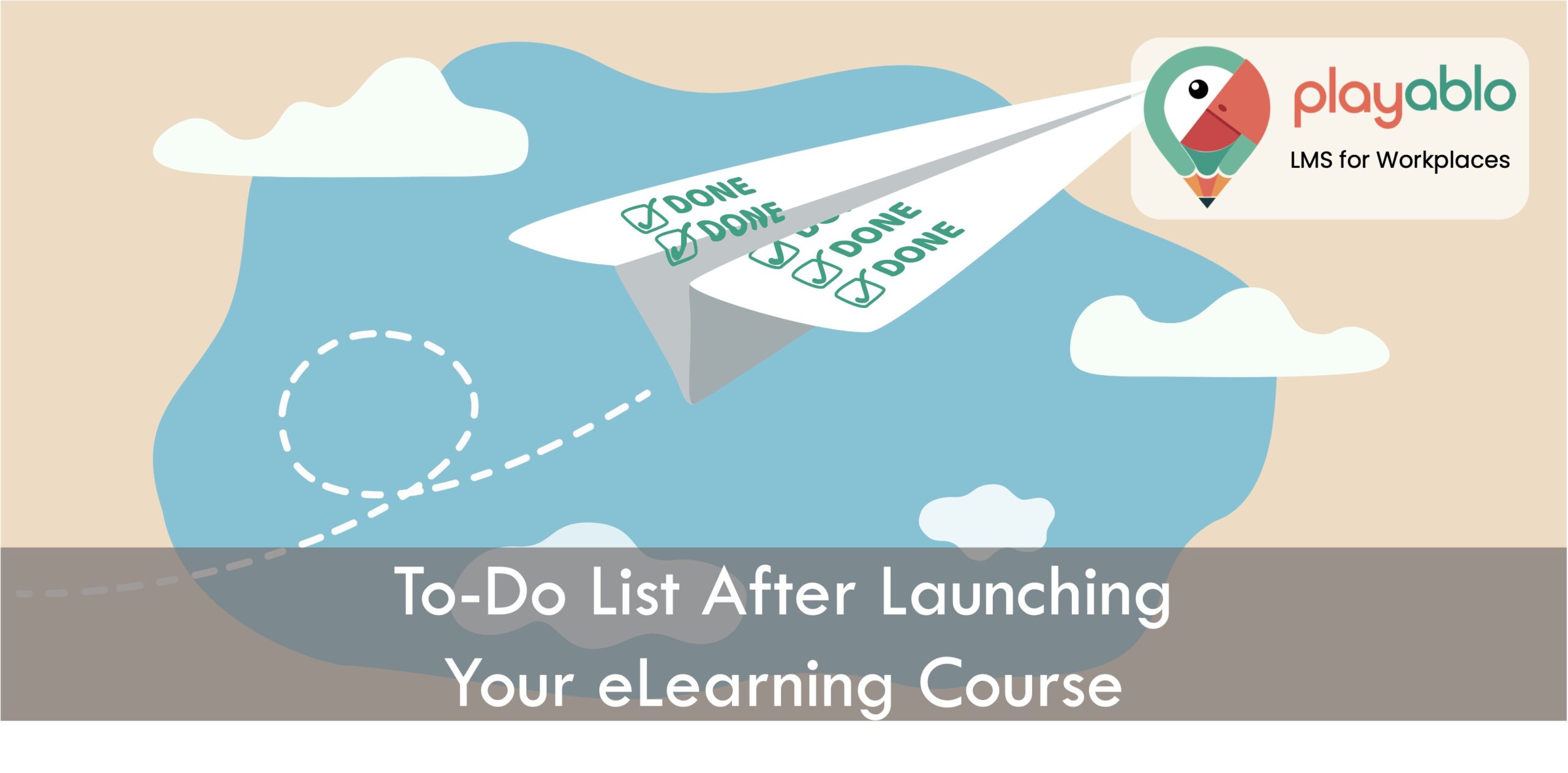
Creating an eLearning course that doesn’t get the attention it deserves is one of the most annoying difficulties that eLearning developers encounter. You’ve carefully selected each piece of eLearning content and considered every detail of the design. However, you notice that attendance rates are low, sales are down, and you aren’t reaching your target audience after implementing eLearning courses. After you’ve launched your eLearning course, there are six things you should always do.
Table of Contents
9 Things You Must Do After Launching an eLearning Course
Conduct a Launch Analysis in Hindsight
After you’ve finished your eLearning course, please take some time and release it to the audience to analyze the entire eLearning design process. Gather feedback from your eLearning team and determine how you might improve moving forward. You might even discover that there are components of your current eLearning course that you can immediately improve, such as fresh eLearning content found through the continuing study by the Subject Matter Expert. This is also an excellent opportunity to review your eLearning budget and delivery schedule to determine if there are any areas where you can save money or make the eLearning process more efficient in the future.
Create a Support Page
Following the deployment of the eLearning course, specific online learners may want additional assistance. For example, they should be able to contact IT service if they cannot log in to the eLearning platform using their username and password. Similarly, online students who have difficulty with a particular area may require assistance from their online teachers or classmates. Create a presence on at least one social networking platform where online students can write comments, ask questions, and stay up to speed on eLearning course developments. If you’re selling an eLearning course, online students will be more likely to buy it if they have access to continuing support. They know they can obtain the help they need for no extra charge when they need it. Please include all of your social media pages’ URLs in the eLearning course design so that online learners can access them.
Make A Promotional Connection
Who doesn’t appreciate getting free information? A promotional tie-in can range from a free add-on module to a free eLearning eBook with helpful hints. Online students who have previously enrolled in your eLearning course will appreciate the bonus. In contrast, new online students will be more likely to join if they find the eLearning helpful resource. You can also utilize the promotional item to encourage people to join your mailing list. Visitors that offer their email addresses, for example, will be given access to your free eLearning video. This is a terrific approach to start building your database so you can send out reminders and launch announcements regularly.
Continue to Interact With Learners
Another issue worth mentioning is the significance of active learning. Students can become more engaged in their learning by relating knowledge to their own (or others’) experiences and applying it to their daily lives through active learning. Here are some suggestions for getting your students to communicate with one another and share their learning experiences: Forums, live sessions, and online group activities are all options.
Use forums to talk about the eLearning course they’re doing, other training, or what they ate for the morning! Anything that stimulates and communicates will suffice, and that’s exactly what we’re looking for. All the better if you can get a handful of thought leaders from your company to participate in the forum.
In general, discussion forums allow users to post a question to which other students respond with answers or possible responses. Trainers keep an eye on the debates and offer some guidance to help them find the right solution. So that’s our suggestion.
Returning to the primary point (interaction), encouraging it has various advantages. Among the most important are:
- Interaction develops critical thinking by allowing students to reflect on their own perspectives.
- It allows students to investigate relevant topics and promotes productive dialogue among students of various backgrounds, opinions, priorities, and skillsets.
- Provides both qualitative and quantitative data. As a result, feedback can be customized more effectively to the learner.
It Should Be Promoted
So, before your course goes live, you should start promoting it. You must, however, maintain the momentum. Once it’s live, you’ll need to ramp up the promotion.
Even if you’ve produced a stunning, functional, and practical eLearning course, you can’t hide it in a dark corner or bury it deep within your LMS’s murky depths. It would help if you communicated it to your audience, giving an “elevator pitch” on why it is worthwhile. Oh, and automatic email from the LMS with the subject ‘new course available’ does not count.
But what other options do you have? Well, you have a few options, and knowing how to use them can help you enhance student engagement, course participation and ultimately deliver a return on investment for your company.
Here are some suggestions:
- Email and blog: Make sure you’re sending out emails on a regular basis (but not too often!) and posting to your company blog (if you don’t already have one!). Remind your audience why they should attend the training, what it is intended to accomplish, and, most importantly, what they will get from it. Keep it short, sweet, and simple, as with anything. Don’t be afraid to go into more detail in longer publications like newsletters and blog articles. Keep it brief, but describe a few more reasons why you created the course, what it’s for, and how the learner and company would profit from it. Because the audience reading these longer-form stories is already invested, they are less likely to say “too long; didn’t read” as soon.
- Consider running a competition for something a little more off-the-cuff and with a little more funding. These are excellent strategies to motivate your employees to complete their training and try out your eLearning course. For example, a monthly prize draw for learners who complete the course within a certain amount of time, or a prize for those who log the most training hours. Isn’t it true that a little bribery never hurt anyone?
Organize a Virtual eLearning Conference
One of the most significant drawbacks of eLearning, particularly asynchronous eLearning, is the lack of a social component. The lack of a “face” that online learners can associate with the eLearning course, as well as a human element, may deter them from enrolling in the first place. This is especially true for more extroverted online students or those who require a boost in the drive. After implementing eLearning courses, you should hold at least one virtual eLearning event so that online learners can connect with peers and facilitators. A webinar, for example, allows people to exchange ideas, receive comments, and obtain answers to their most pressing problems. It also boosts online learner motivation and engagement by requiring them to actively participate in the eLearning experience to reap the full benefits.
Analyze Learner Feedback and Analytics
Examine the results of all your eLearning surveys, focus groups, and interviews for patterns and trends. Are online students satisfied with their eLearning experience as a whole? Do they think there are any areas of the eLearning course that could be improved? What aspect of the eLearning course do they enjoy the most? It would help if you also looked at your existing Learning Management Systems and website analytics. Determine whether any components of the eLearning course design are too tricky or not tricky enough. Are online students acing eLearning examinations with ease, or are they having trouble? How long does it take them to finish each eLearning lesson? As a bonus, happy online students can leave testimonials that attract other students. Please make an offer to them, such as a free spot in your next webinar or eLearning course.
Make a Future Plan
The data and eLearning feedback you’ve collected may or may not apply to your current eLearning course. However, it may be helpful for future eLearning initiatives. It’s critical to think about your next eLearning course design and plan for the future. Your online learners will most likely be hungry for additional information after completing this round of eLearning. You want to be sure you can meet demand and provide customers with the required information. This isn’t to say you should ditch your present eLearning course or stop supporting or promoting it. Set out sometime each day to develop new ideas and meet with your eLearning team to map out a strategy. Fortunately, you now have a greater understanding of what your online students want and how you can assist them in achieving their goals.
Reuse and Recycle
Learners, of course, tend to forget things over time. We all do it, just as when I can’t find my keys in the morning, afternoon, or nighttime. In any case, we utilize the phrase “reuse and recycle” in the classroom. This means you may choose a method of reminding your learners of the subject they’ve studied every 3 to 6 months or in a cycle of your choosing. This can be adjusted depending on the importance of the skills – for example, if your health and safety training program isn’t producing results and accidents are still occurring, consider recycling the course sooner!
Aside from that, there are a few diagnostic methods you may use to see if your students need a refresher:
- Failure to finish the eLearning (of course!)
- Workplace standards are lower, and there are more mistakes or issues at work.
- Failure to successfully implement new concepts
If you don’t want to re-learn the entire course, you can use microlearning as a refresher strategy. This can be a fun follow-up to your training and enhance your current curriculum. Send a summary quiz, an interactive video, or even a short eBook a week or two after the course ends to reinforce their learning and keep it fresh in their minds.
Conclusion
Your audience will benefit significantly from your eLearning course if they locate it. Promoting your eLearning course is critical, as is utilizing the eLearning feedback you currently have to improve its marketability. Make sure your eLearning course gets off to a good start with these 9 suggestions and strategies.







Comments are closed, but trackbacks and pingbacks are open.